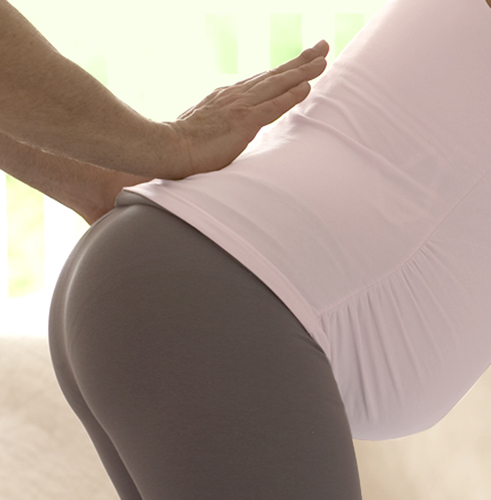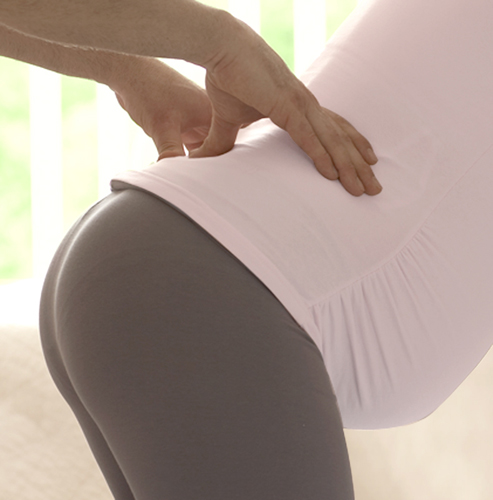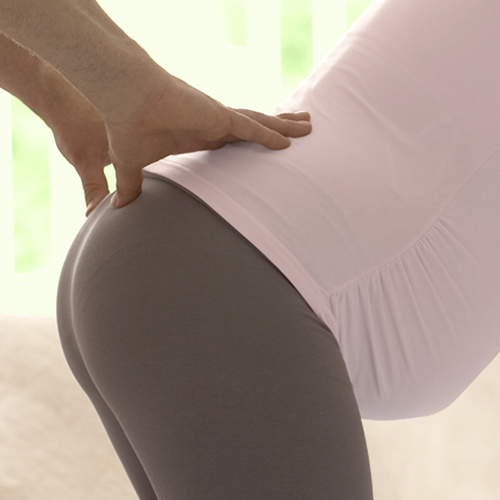Massage and touch
Many women find massage helpful in labor
to induce relaxation, bring about a sense of well-being, and alleviate
pain. Your birth partner may find it relaxing and therapeutic too.
Ideally, he or she will have had a chance to see massage techniques
demonstrated in prenatal classes and to practice before labor. Massaging
the lower back helps relieve pain in this area; head, neck, and
shoulder massage is beneficial for relieving tension and fatigue.
The touch therapies
shiatsu and acupressure can also help relieve pain and tension. They
involve application of pressure to specific points to increase endorphin
levels. You or your partner will need to learn the techniques from a
trained practitioner. Ask your doctor if she can put you in touch with a
practitioner.
Your partner can use the heel of his hand to apply firm pressure to your sacrum. The hands can be alternated to stroke around the lower back.

Using the thumbs
to massage the lower back in a circular motion, working from the base
of the spine down to the buttocks, can release tense muscles.

Applying deep pressure to the buttocks and lower back with the thumbs can help you focus and release held-in tension during contractions.

A natural home birth
Jenna is a 31-year-old
mom and this is her second labor. She had a straightforward birth with
her daughter, now three. This pregnancy was uneventful, so she decided
to have a home birth this time.
Jenna’s story: When I was eight days overdue, my midwife did a “stretch and strip” of my cervix to encourage labor. I then had a couple of bloody shows and irregular contractions. In the night I woke with contractions 20
minutes apart. I couldn’t get back to sleep, so I had a warm bath, took a
couple of acetaminophens, and went back to bed. My daughter woke at
6:45 am and we had breakfast. My contractions were every 10 minutes and
getting stronger, so my husband stayed home.
By 8:00 am, my contractions
were every 5 minutes, stronger, and lasting 50–60 seconds. My husband
called the midwife. She said she was on her way and advised me to stay
active. I started to use the TENS machine
on a low setting, which helped me focus. I found standing and rocking
my pelvis back and forth and from side to side helpful and I used a
birthing ball. My husband was supportive, massaging my shoulders and
under my abdomen where it hurt most; I found the heat from his hands
soothing. My daughter held my hand.
At 8:40 am, the
midwife arrived. She checked my blood pressure, pulse, and temperature,
felt my belly, listened to the baby’s heart, and took a urine sample,
which relieved some pressure in my pubic area. She confirmed that I was
in established labor since my cervix was 5 cm dilated. My cervix was
thinning, the head was pressing down, and my membranes were intact. I
remained active, using TENS, and leaning forward. My husband put on a
relaxing CD.
At 9:50 am my
contractions were every two minutes, very strong, and lasting 60
seconds. I tried walking and marching on the spot. My mom arrived and
took my daughter to the park. I felt hot and so I had a cool drink and
my midwife dabbed my face with a cool, wet cloth. I found kneeling on
all fours, rocking and arching my back, helpful.
By 10:30 am my contractions were very painful. My midwife listened to the heartbeat intermittently.
By 11:00 am I felt an
urge to push. My water broke and my contractions were very strong and
each minute. I felt panicky, but my midwife encouraged me, saying she
thought the baby would be born soon; my husband helped me focus by
breathing slowly. My midwife confirmed that I was fully dilated and
ready to push. I somehow found the energy to bear down and felt the head
emerge. I took a breath, concentrated, and pushed my baby out. My baby
boy was born at 11:14 am, 8 lb 2 oz, and my husband cut the cord once it
had stopped pulsating. I delivered my placenta without drugs .
My midwife advised me to put my baby to my breast to stimulate the
hormone oxytocin, which causes contractions and helps the placenta to
come away. My placenta was delivered at 11:40 am.
The midwife’s comments:
Jenna and her husband prepared well and worked as a team. Jenna was
active for most of labor, and stayed focused. Her feelings of panic in
the transition period were normal, but her husband and I gave her extra
support. By working with her instincts she found inner strength and had a
normal birth. Her labor was nine hours, about average for a second-time
mom.